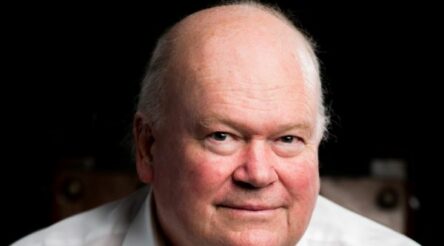Looking forward to the long haul (podcast)

Rux Energy wants to be the first in the world to increase hydrogen storage density with novel molecular sponges. Brent Balinski speaks to founder and CEO Dr Jehan Kanga.
Metal organic frameworks have only really been studied since 1999, says Dr Jehan Kanga (pictured), who studied a PhD on these nanoporous materials and is now trying to exploit their properties for the green energy era.
As is sometimes the case with wonder materials at an immature phase of development, MOFs are made in grams or kilograms per batch, and enterprises around the world are trying to figure out things like reproducibility as well as how to make useful volumes.
“If you were to go to the Tier 1 chemical retailer in the world and you were to order a kilo of one of the very famous MOFs that is a publicly known formula, the batches will give different performance. If you were to run gas adsorption on them you’d get different performance with different batches,” Kanga tells us, seemingly unperturbed by this and other challenges.
“On our most ambitious target we would need to be making 75,000 tonnes of MOF a year by 2029 and no-one has ever made that much MOF. If you took all the MOF that’s ever been made in the world it wouldn’t get to more than 1,000 tonnes, I would imagine.”
The energy transition has emerged as a place where MOFs might be made commercially useful.
The materials’ use with hydrogen drew Kanga in during studies as a chemist in the University of Sydney group led by Professor Cameron Kepert, a world-renowned expert in MOFs.

Composite pressure vessels for hydrogen storage (credit Optimum Composite Technologies)
A late-PhD breakthrough and patent went on the backburner during a post-study stint at KPMG. Rux has been Kanga’s focus since 2021, with collaborative projects supported through the CRC-Projects, Innovative Manufacturing CRC activate, and ARC Linkage programs.
The goal is incorporation in composite pressure vessels to double the volumetric density of hydrogen, and without requiring very low temperatures or very high pressures. The two markets being focussed on are heavy transport – with potentially increased trucking hauls and system longevity a selling point – and aerospace.
Jehan is part of the remarkable Kanga family, all of which have attained PhDs: father Rustom is an artificial intelligence entrepreneur, brother Zubin is an award-winning pianist and composer, and mother Marlene is a pioneering leader in the nation’s engineering community, whose career includes president at both Engineers Australia and the World Federation of Engineering Organizations. (She is currently chair of Rux’s board.)
Jehan credits their mother’s career and the importance of values underpinning her technical work as an inspiration.
“We want to change the way people think about startups as being just about the single bottom line – grow as quickly as you can, pump and dump kind of business,” says Kanga.
“We are here for the long haul. We want to force an increase in the velocity of the energy transition.”
In this episode of @AuManufacturing Conversations with Brent Balinski, Kanga tells us about their research and commercialisation of MOFs, how these can be used to boost the efficiency of hydrogen, how quickly the green hydrogen era is approaching us, and much more.
Episode guide
0:38 – An introduction to Kanga, Rux, and metal organic frameworks. Why they could be particularly useful for hydrogen-powered trucks.
2:50 – The influence of family in Kanga’s career, particularly of Dr Marlene Kanga, Jehan’s mother and a pioneering female leader in Australian engineering.
5:30 – “We want to change the way people think about startups.”
6:20 – “WTF is a MOF?”
7:50 – The newness of the field and why Kanga was drawn to it.
10:42 – How MOFs are made and why they’re pelletised.
12:25 – Volumes, quality and reproducibility.
15:06 – Incorporating them into a tank. “The people who would be buying our MOFs wouldn’t be buying MOFs in bags or in bottles and powders or pellets. They would just be receiving the final tank solution, because we’re taking on some of the risk around making sure they’re certified to ISO/TC 197 suite of standards around composite tanks.”
16:10 – A second set of discoveries made late in Kanga’s PhD. However, “no-one was interested in hydrogen in 2015-16.”
17:30 – The benefit of taking a job at KPMG post-PhD.
19:02 – The climate tech innovation scene begins to pick up in 2019.
22:04 – The lesson of coordination and cooperation. “You have to make friends with a lot of people to get anything big done.”
23:30 – Funding so far.
24:20 – Rigs currently being built in Victoria.
25:15 – “The market is moving much more quickly than we thought” for green hydrogen. Countries in the global south are leading the world with investment.
27:10 – A couple of champion materials being productised in parallel. “ It’s basically taking the… big pharma approach to discovery.”
27:55 – The different needs of trucking applications versus aerospace ones for hydrogen storage.
30:10 – Why it’s wrong to compare green hydrogen with grid power.
32:10 – How the price of green hydrogen is likely to fall fast, and reasons to be optimistic.
35:30 – “Australia, I think, needs to really needs to reevaluate its strategy and invest hard, because… it is becoming a laggard.”
36:20 – Why older manufacturers need to be helped to modernise and succeed.
38:50 – Final words.
Further reading
HYDROGEN STORAGE, ELECTRIC AIR TRANSPORT, PLANT-BASED PROTEIN AMONG $47 M CRC GRANTS
MANUFACTURING NEWS BRIEFS – STORIES YOU MIGHT HAVE MISSED
AUSTRALIA CAN BE A CHEAP SOURCE OF GREEN HYDROGEN BUT FACES COMPETITION
GREEN HYDROGEN IS ELECTRIFICATION
Main picture: supplied
@aumanufacturing Sections
Analysis and Commentary Awards Defence Manufacturing News Podcast Technology Videos










